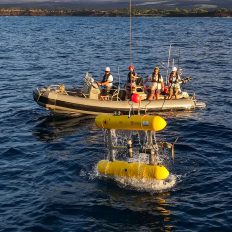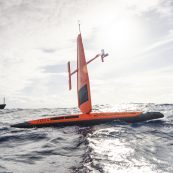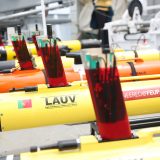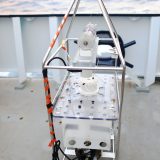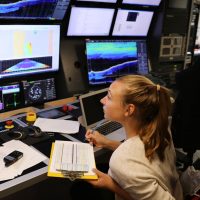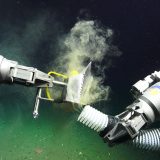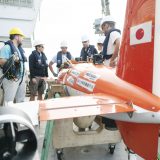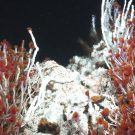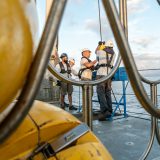Improved marine surveys by teaching robots to collaborate and share knowledge
Coordinated Robotics 2, Hawaii
Demonstrated from aboard Falkor coordinated operations and data-driven site selection with multiple autonomous underwater vehicles. Refining techniques using several vehicles will make habitat mapping simpler and easier for a more scalable approach that can present follow-on benefits for management and policy-making.
Achieved the longest deployment of Environmental Sampling Processors on Long Range AUVs
Eddy Exploration & Ecosystem Dynamics, Hawaii
Completed the first open ocean deployment of long range autonomous underwater vehicles (LRAUVs); they are the only AUVs that can survey filtered seawater insitu and allow for sampling in remote or dangerous locations. Seawater collected with the LRAUVs is being sequenced to determine microbial communities found at the ocean surface, this is important baseline information to have as seawater temperatures increase.
Protected white sharks with Saildrones and shipboard eDNA
Voyage to the White Shark Cafe, California
Documented the oceanographic conditions and biological productivity of a white shark congregation zone. This was achieved with a multi-platform sampling program coupling Falkor, SuBastian, and two Saildrone autonomous surface vehicles, gathering crucial ocean currents and animal density data. The data will illuminate this little-studied ecosystem and contribute to the conservation efforts of the high seas.
Located and mapped a Pacific subtropical ocean front using a coordinated fleet of robots
Exploring Fronts with Multiple Robots, California
Tracked, mapped, and sampled a mesoscale filament of a major ocean front with multiple autonomous underwater, surface, and aerial vehicles using open-source communication. The technologies represent an important step towards achieving the levels of persistence, spatial and temporal resolution, as well as coverage, required for ocean studies in a changing climate.
Tested in situ microbial incubators to understand how marine life adapts to oxygen depletion in the ocean
Solving Microbial Mysteries, California
Tested and refined an autonomous in situ incubation device allowing shipboard scientists near-continuous monitoring in an oxygen deficient ocean system. The seawater incubations will provide better insight into how microbes interact with each other and their chemical environment. The refinements in low oxygen marine system operations will help scientists better understand the ocean’s role in moderating climatic changes.
Reached non-science audiences with artistic visualization of marine data
The Seeping Cascadia Margin, Oregon
Created detailed mid-water and seafloor maps in an unsurveyed methane seep region with six artists and two Student Opportunities participants. The maps will be used to identify where hydrocarbon seeps are occurring and their flow activity for future observation and research. The artists captured the mapping work of Falkor’s shipboard marine technicians with striking art forms including a light painting performance, oceanscape resin art, woodworking sculpture, portrait painting, cyanotype prints, and a life-size mural of the Pseudoliparis swirei ghost fish.
Guided exploration and research of changing seafloor habitats with AI
Characterizing Venting and Seeping, California
Gained insight into the role of gas vents and seeps in the ecology of the Southern California Borderland, using ROV SuBastian and the advanced seafloor observatory (ABISS). The ABISS lander deployments showed that methane venting is more episodic than previously known, which changes assumptions about methane escape from the seafloor to the atmosphere. The science team is producing a map of the contiguous seeps and analyzing the relationships among the animals, including potentially new species, to understand the connectivity of these habitats.
Developed new ways to understand ocean cycles via methane bubbles
Hunting Bubbles: Understanding Plumes of Seafloor Methane, Oregon
Installed a novel bubble capture system on ROV SuBastian to take chemical measurements of bubble composition and gather data on the chemical dynamics of bubbles. The development of this equipment (and cutting-edge sensors) is important in illustrating changes in methane from venting locations across a spatial scale and over time. The large flux of this methane into the ocean may indirectly play an important part in the carbon cycle, which is closely linked to Earth’s climate.
Revealed new sites and species in the California Borderland
Adaptive Robotics at Hydrate Ridge, Oregon
Used unsupervised learning techniques with 3D reconstruction pipelines to analyze imagery collected between AUV deployments. As a result, the largest known continuous photogrammetric reconstruction of seafloor mapped at sub-centimeter resolution was created, including an 11.4 hectare dense 3D image reconstruction. Developing end-to-end autonomy is critical to scale robotic operations so that hundreds may be deployed simultaneously in the future, giving scientists the ability to monitor larger areas and understand the ocean more efficiently
Conducted centimeter-scale AUV survey of hydrothermal vents in Pescadero Basin
Interdisciplinary Investigation of a New Hydrothermal Vent Field, Mexico
Completed centimeter scale resolution mapping resulting in the discovery of a new vent field (JaichMaat). The list of species occurrences for the area was significantly expanded and the team collected several animals that may represent new species. The discovered site is an important location to try to understand how vent fauna colonize, evolve, and speciate.
Tested AI-driven robots for a possible extraterrestrial mission
New Approaches to Autonomous Exploration, Costa Rica
Operated multiple self-controlled robotic vehicles while successfully developing AI for autonomous exploration and research of remote uncharted environments. This technology will support future oceanographic and planetary exploration, where due to communications latencies robots routinely need to make tactical decisions without human intervention.
Broadened participation in ocean sciences
Doubled viewership of incredible 4K deep-sea imagery from ROV SuBastian. This resulted in the use of footage in documentaries, television, and museum exhibits at the Dundee Heritage Trust, and Barbican Museum. We also hosted public ship tour days during US port calls, bringing more than 1,000 people on board. Additionally, SOI continued our traveling Artist-at-Sea exhibit showcasing 11 new artists at venues including Aquarium of the Pacific, Exploratorium, and the NOAA Exploration Forum. The works incorporate data collected during expeditions and have been used for outreach by the scientists as well.

